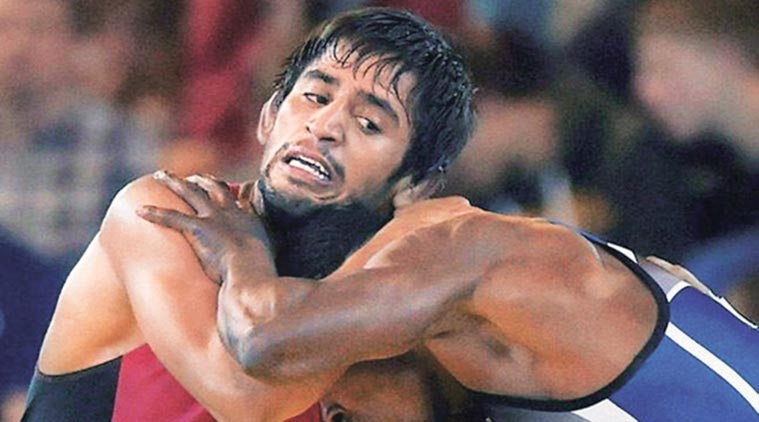Bajrang Punia leads India’s group of new hope in World Cup
India’s first step in the post-Sushil Kumar-and-Yogeshwar Dutt era will be in Iran at the World Cup.
 At the world stage, this will be Bajrang’s first major tournament in 65kg.
At the world stage, this will be Bajrang’s first major tournament in 65kg.
It’s a pleasant late winter morning. A dozen or so wrestlers are going through their punishing drills inside the dimly lit ‘Sushil Kumar and Yogeshwar Dutt Wrestling Hall’. But neither Sushil Kumar nor Yogeshwar Dutt are at the Sports Authority of India’s Sonepat centre.
They possibly never will be. An official announcement might not have been made yet, but it’s extremely unlikely that India’s two Olympic medallists will step on the wrestling mat again. For the first time in more than a decade, India began its Olympic cycle without two of its most decorated Olympians. India’s first step in the post-Sushil-and-Yogeshwar era will be in Iran at the World Cup.
The two days in Iran will be a test for India’s next gen, which — for good or bad — was always shielded by the veteran duo. Apart from being the flag-bearers, Sushil and Yogeshwar have also been the two power centres of Indian wrestling. Almost inevitably, wrestlers from that generation — and the ones that followed immediately — aligned themselves to one of the two groups.
There has never been a lack of respect among them, they hugely admire each other’s pehelwani, but the generous sprinkling of akhara politics —the daav pench – added to the intrigue and altered equations among the wrestlers, including Sushil and Yogeshwar themselves.
So Bajrang, who learnt the finer aspects of wrestling at the Chhatrasal Stadium, home to Sushil, was taken under his wings by Yogeshwar in 2008. The future Olympic medallist had a huge impact on the then 14-year-old Bajrang and the two have been inseparable since. “Bhai hai mera,” Yogeshwar once said of Bajrang, who sees it more as a ‘guru-shishya’ (mentor-protégé) relationship. The shishya would also make a lot of sacrifices. Both competed in the same weight category. So for important tournaments, Bajrang would willingly take a step back and let Yogeshwar compete. Later, when the categories were re-jigged by the international federation, Yogeshwar moved to 65kg and Bajrang went up by a kilo to 61. But it wasn’t his preferred category. Whenever Yogeshwar would opt out of a tournament, Bajrang would compete in the 65kg — but that was primarily at the Commonwealth Championships, which lacked competition, or Asian-level tournaments.
First biggie
At the world stage, this will be Bajrang’s first major tournament in 65kg. “It’s not that I haven’t learnt. Yogi would teach me a lot,” Bajrang says. “Now I have three years till the next Olympics. That’s enough time to get some experience in 65kg. At the World Cup, I’ll know if I am lacking in power, stamina, technique…”
It’s not just here that Bajrang has been living in someone else’s shadows. In 2013, he won a bronze medal at the World Championships in Budapest. But a day before, Amit Dahiya had won a medal of a better colour. Bajrang and Dahiya are of the same age and began their career almost simultaneously at Chhatrasal. But Dahiya’s silver was India’s first World Championship medal since Sushil’s gold in 2010. That, and the Chhatrasal link, meant he was conveniently dubbed as the ‘next Sushil.’
Recognising his potential, the two-time Olympic medallist and his coach Satpal channelised their resources on Dahiya. So the akhara allegiances were informally drawn: Dahiya with Sushil and Bajrang with Yogeshwar. The rest simply joined one of the two camps depending on their comfort levels and some, mostly from Maharashtra, chose to stay aloof. On Thursday, the protégés will formally take over the mantle from their mentors as Indian wrestling dares to look beyond Sushil and Yogeshwar. At the World Cup, Bajrang and Dahiya will be the two most experienced wrestlers in an Indian squad that barely inspires confidence.
For Bajrang, this will be a first world-level test in the 65kg category in which he is India’s undisputed best. But for Dahiya, the challenge is bigger. He made it to the squad only because of an injury to Utkarsh Kale, India’s favoured wrestler in the 57kg class.
In other weight categories, India will be repesented by Harphool in 61kg, Amit Dhankar in 70kg, Jitender in 74kg, Deepak in 86kg, Roublejit Singh Rangi in 97kg and Krishan in 125kg. India open their campaign against Mongolia on Thursday followed by Iran in the second round and Turkey in the third.
Freeze style
Placed among heavyweights, India’s medal prospects look bleak in the freestyle World Cup to be held in Teheran on February 16 and 17 .
Bajrang’s hurdles: Competing in his first-ever international event since moving up from 60-65kg, Bajrang (in pic) will face some of the finest in the circuit. Like Turkey’s European silver-medallist Mustafa Kaya and Asian Champion Meysam Nasiri of Iran.
Amit’s challengers: He will be competing in his first major event after an injury-chequered 2016. Though his potential is beyond dispute, his task won’t be any easy, as he will be up against another Iranian Hassan Rahimi, a bronze-medallist in Rio.
Team effort: Since each team needs to win five out of the eight bouts, it would require a concerted effort from other members of the squad, which reduces India’s prospects, as the three other teams—Iran, Mongolia and Turkey have plenty of quality in the ranks.
































